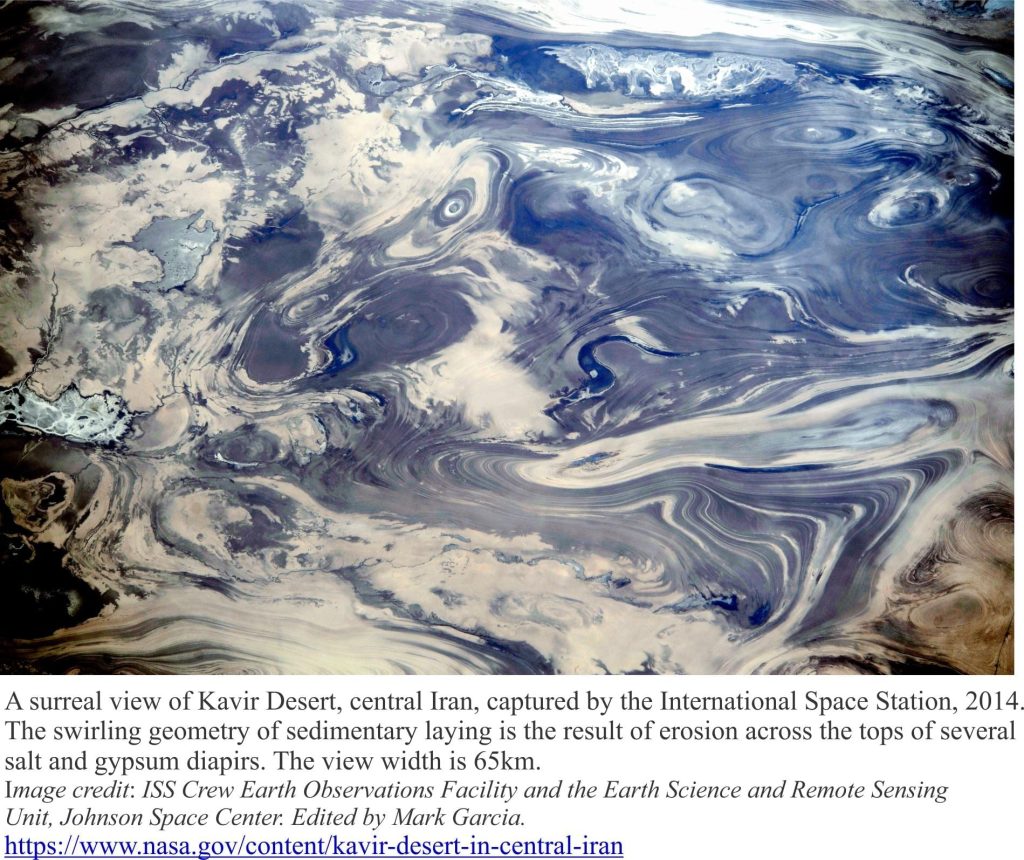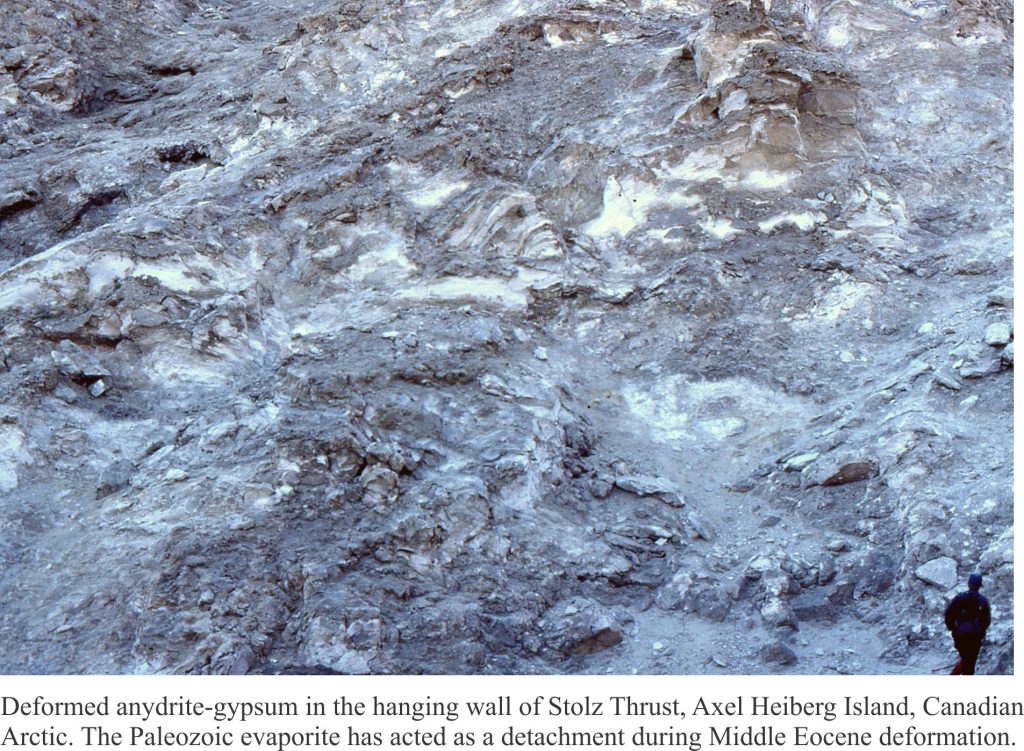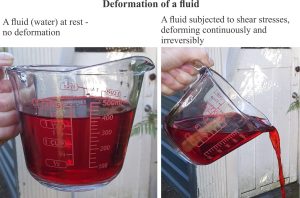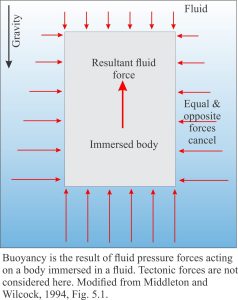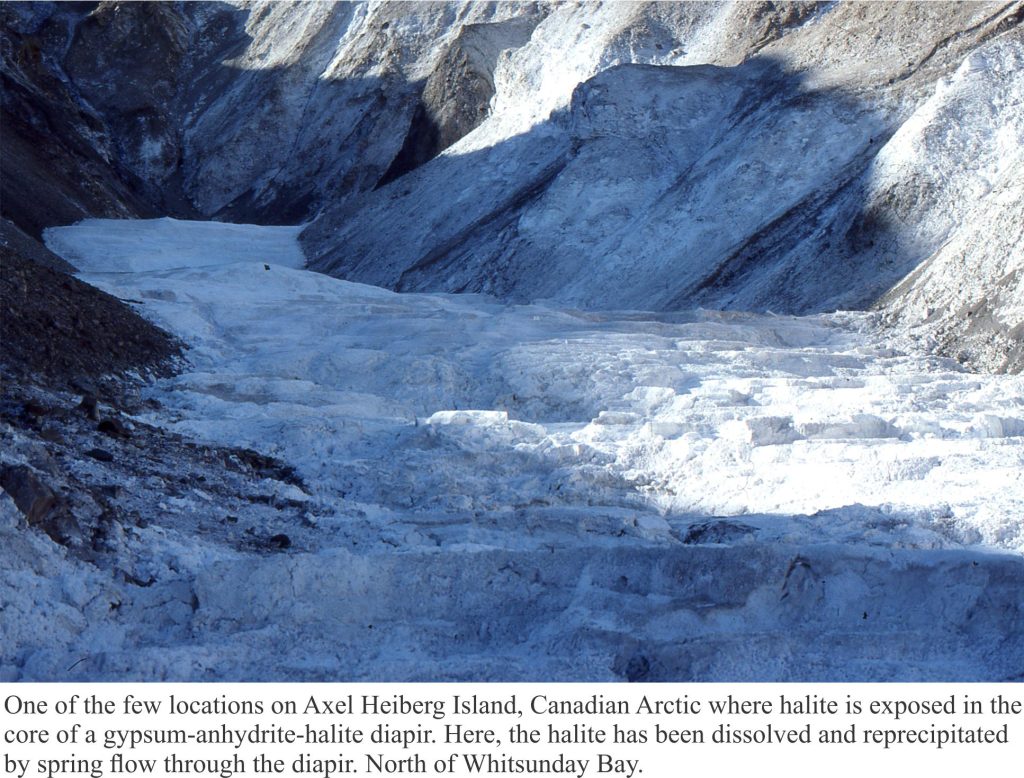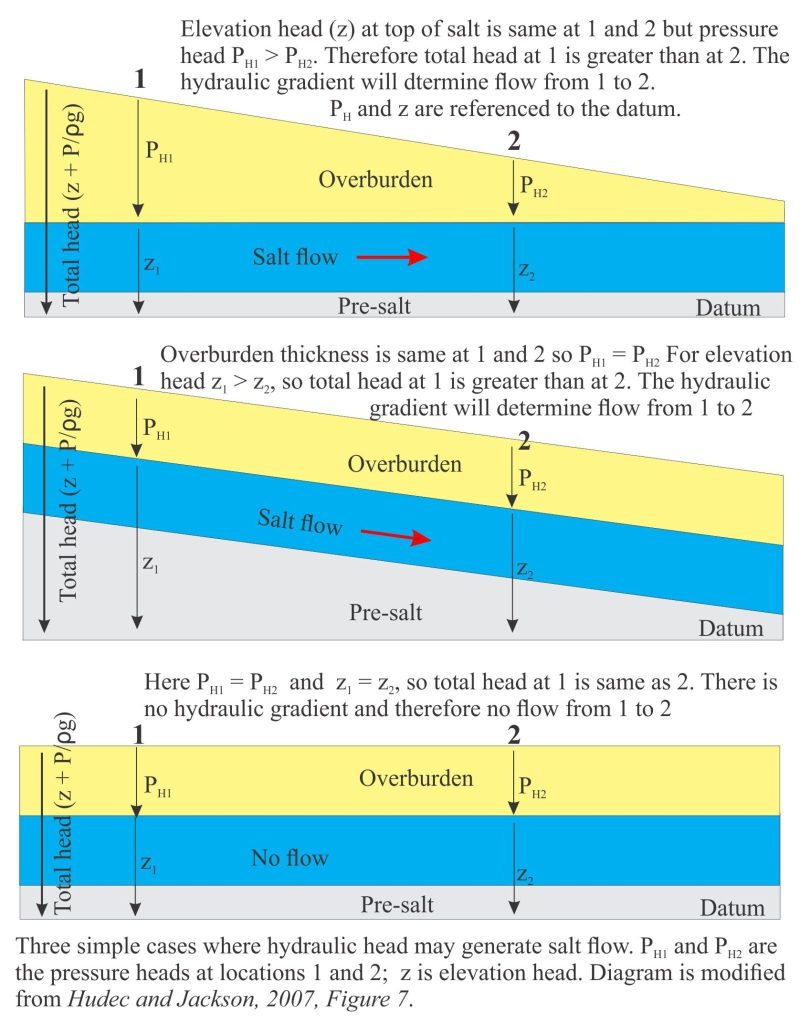This post focuses on the mechanics of salt flow and diapirism
This is part of the How To…series on evaporites
The rock record shows us that thick, basin-wide salt deposits accumulated in active rift, passive margin, intracratonic and even foreland basin settings, where there was the happy congruence of climate, isolation from regular and frequent access to normal seawater, and a negative water balance over geological time periods. However, salt once deposited and buried is highly mobile and prone to deformation, producing spectacular intrusive bodies such as diapirs, and acting as detachments in thrust belts. Salt tectonics also impacts depositional patterns and the geometry of strata in sedimentary basins.
An examination of salt tectonics provides us with a good excuse to consider some of the contrasting mechanical properties of salt and associated rocks, including the relationship between stress and strain and in particular rates of strain (rheology), the conditions where rocks act as fluids, and the role of buoyancy.
Much of the information presented here is gleaned from publications by Martin Jackson and Michael Hudec (Hudec & Jackson, 2007; Jackson & Hudec, 2017).
Some basic mechanics of salt
Salt deposits consist of halite and variable amounts of gypsum and anhydrite. All are crystalline solids at room temperature and pressure. The contrast in their densities is shown on the accompanying image. Salt also has negligible compressibility which means that as it is buried, it’s density changes very little. In contrast, the density of siliciclastic and carbonate sediment does increase with compaction during burial. At depths greater than about 1500m, the contrast in density between salt and the overlying strata renders the salt unstable with respect to gravity. Salt permeability is also very low; the possibility of using thick halite deposits for storage of nuclear waste is well documented.
Salt is mechanically weak compared to siliciclastic and carbonate rocks; Martin P Jackson, the doyen of salt tectonics, refers to this property as the Rosetta Stone of salt mechanics – it helps to explain pretty well everything about the way salt behaves. If you take a lump of salt and hit it with a hammer, it will shatter (along planes of cleavage). Under these conditions, it behaves as a brittle solid, subjected to very high rates of strain (basically rates of deformation) under zero confining pressure. A geological analogy is the rupture of faults during an earthquake.
Now, bury this salt under several kilometres of stratified sediments and volcanics over geological periods of a few million years. The salt layer is now subjected to lithostatic pressure (weight of overlying rock). The temperature will also increase according to the geothermal gradient. Salt under these conditions acts as a fluid, even though it’s host strata (sedimentary and volcanic rocks) behave as mechanically stronger solids.
When stress is applied to a fluid, it deforms permanently (i.e. it is not reversible) and continuously – a true fluid will not behave elastically (i.e. it will not return to its original size and shape when deformation forces cease); a fluid has little or no shear strength. The example we are all familiar with is water – it deforms the instant a stress is applied. An increase in viscosity will change the rate of deformation, but not the nature of it. At this point in the discussion we need to introduce the concept of buoyancy.
Buoyancy
When Archimedes jumped into his bath, little did he know that his rationalization about displaced water would have an impact on our understanding of important geological processes such as isostasy, the rise of magma – and salt. A body immersed in a fluid will be subjected to fluid pressures that act on all parts of the body surface. This applies to solids immersed in a fluid, and less dense fluids immersed in a more-dense fluids. The diagram, borrowed from Middleton & Wilcock (1994, Fig. 5.1) shows fluid pressure forces acting on all parts of the immersed body, such that the resultant buoyant force is directed upwards.
Early models of salt diapirism treated the sediment-volcanic cover as a dense fluid that sank around the underlying, less dense salt, forcing the salt upward. However, it has become increasingly apparent that the overburden does not act as a dense fluid, but is a mechanically strong layer subject to brittle failure. The strength of the overburden can prevent salt movement. Furthermore, detailed mapping of deformation within salt bodies indicates the role of friction forces that restrict movement along diapir margins. Thus, salt will not begin to flow unless both the opposing forces of overburden strength and friction forces are overcome.
Three basic mechanisms have been proposed to counter the opposing forces and initiate salt flow: they are grouped under the general heading Differential Loading. Note that the three mechanisms do not necessarily operate independently – they may operate in tandem, or at different times during salt deformation:
- Gravitational loading occurs when differences in thickness or inclination of the overburden create gravitational instability in a salt layer. This mechanism borrows the concept of hydraulic potential from fluid dynamics, or hydraulic head (because we treat salt as a fluid). Hydraulic head, even though it is measured in units of length (metres or feet of head) is an expression of the potential energy available to perform mechanical work on that fluid – i.e. the work to move the fluid from point A to point B. I have discussed the derivation of hydraulic head in another post. The outcome of this discussion can be represented by the equation:
Total hydraulic head h = z + P/ρ.g
where the two components of head are an elevation head (z), and a pressure head (relative to a datum; ρ = fluid density, g = gravity constant). Fluid will flow from a region of high head to low head, in other words, along a head gradient (or hydraulic gradient). The diagram below, modified from Hudec and Jackson (2007) illustrates three end-member conditions where salt flow may or may not be initiated depending on the presence or absence of a hydraulic gradient.
- Displacement loading of salt occurs when external tectonics produce shortening (contraction) or extension of the salt flanks, commonly along pre-existing structures. Contraction results in uplift, and extension in subsidence of the salt body.
- Thermal loading results in expansion of salt during regional or local heating events. Because heating may also occur differentially, it can produce convection and deformation within the salt body.
The emplacement of diapirs and related salt intrusions is the subject of the next post in this series on evaporites. Mineralogy of evaporites: The rise of diapirs
Related links
Mineralogy of evaporites: Marine basins
Mineralogy of evaporites: Saline lakes
Mineralogy of evaporites: Saline lake brines
Mineralogy of evaporites: Death Valley hydrology
References
M.R. Hudec and M.P.A. Jackson, 2007. Terra infirma: Understanding salt tectonics.Earth Science Reviews, v. 82, p. 1-28. Excellent summary. Available for downloading
M.P.A. Jackson and M.R. Hudec, 2017. Salt tectonics: Principles and practice. Cambridge University Press. An encyclopaedic compilation
G.V. Middleton and P.R,. Wilcock. 1994. Mechanics in the Earth and Environmental Sciences. Cambridge University Press, 459 p. An excellent text that takes you through the principles and maths of some fundamental geological processes.
